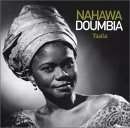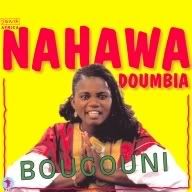 Doubma was born in Mafele, near the border with the Ivory Coast. She was raised by her grandmother, her mother having died shortly having given birth to her. But before she died, Doumbia's mother predicted that her daughter would be a singer — this was a little surprising, since she didn't come from the jeli caste, the hereditary singers. It was something her grandparents tried to fight, but it seemed as if the prediction was correct.
Doubma was born in Mafele, near the border with the Ivory Coast. She was raised by her grandmother, her mother having died shortly having given birth to her. But before she died, Doumbia's mother predicted that her daughter would be a singer — this was a little surprising, since she didn't come from the jeli caste, the hereditary singers. It was something her grandparents tried to fight, but it seemed as if the prediction was correct. Nahawa would sing with her friends, and was eventually discovered in 1980 by civil servants from the country's Ministry of Culture, and persuaded to sing in the National Youth Week, organized by the Ministry to discover new talent. Doumbia won the contest, singing "Tinye De La Laban," which brought government support for her singing, allowing her to develop her style, based on the traditional didadi rhythm of her native region.
"Nobody was allowed to sing in my family. That is why it has been so hard for me to come to music. One day, agents of the Malian Ministry of Culture came to see my father and told him that I should take part in the "Youth Week" local event. He refused but I eventually was able to take part in it. Then I came to Bamako to compete at the "Youth Biennial", an event showing young artistic talents from Mali. I have been prized in 1980 with one of my songs [Tinye de be laban]. It was the very beginning of my career..."
 After some experimentation with Western sounds on "Didadi", Nahawa collaborated with African musicians including members of Salif Keita's band, to created a more authentic African sound. This was reflected on "Magoni" produced in 1993. However, on the album "Yaknaw" in 1997, Nahawa produced a true Wassoulou sound, that was often compared to to that of Oumou Sangare. Nahawa sings of social themes, choosing to focus on issues like the position of women in Malian society, the rights of women and children, and the difficulties facing African immigrants in Europe, she also speaks out against polygamy.
After some experimentation with Western sounds on "Didadi", Nahawa collaborated with African musicians including members of Salif Keita's band, to created a more authentic African sound. This was reflected on "Magoni" produced in 1993. However, on the album "Yaknaw" in 1997, Nahawa produced a true Wassoulou sound, that was often compared to to that of Oumou Sangare. Nahawa sings of social themes, choosing to focus on issues like the position of women in Malian society, the rights of women and children, and the difficulties facing African immigrants in Europe, she also speaks out against polygamy.The most sublime experimentation with combining the Wassoulou sound with Western music, came with the album "Yaala". Working with her band, who played largely traditional instruments, plus French producer/guitarist Claude Barthelemy, she forged a truly incisive sound, that captured her voice at the height of its power. This occurred at when she was being featured on Frederic Galliano's Frikyawa Collection 1, taking tracks from the French label Cobalt, and remixing them for the dancefloor. Doumbia also played U.S. dates with Galliano supporting her band with turntables and DJ-inspired electronic effects, for an almost perfect synergy of the ancient and modern that brought "Yaala" much international acclaim.
Nahawa has become a Malian icon, preserving the charm of her young voice and becoming one of West Africa's most distinctive divas. She is also one of the most popular singers from the Wassoulou region of Southern Mali. Open to new musical encounters and experiences, she has collaborated with numerous Western musicians. On her musical effort, "Diby", recorded in 2004, Nahawa has returned to Wassoulou instrumental traditions by employing the balafon, djembe, kamele n'goni and guitars.Listen to Nahawia Doumbia on
Kemet Music Radio
Discography:
Album : Didadi
Label : M..lodie
Year : 1989
Album : Nyama Toutou
Label : Syllart
Year : 1990
Album : Mangoni
Label : Syllart
Year : 1994
Album : Yankaw
Label : Africolor/Cobalt
Year : 1997
Album : Bougouni
Label : Syllart
Year : 1999
Album : Yaala
Label : Africolor/Cobalt
Year : 2000
Album : Diby
Label : Africolor/Cobalt
Year : 2004

No comments:
Post a Comment